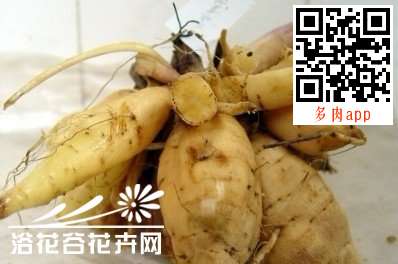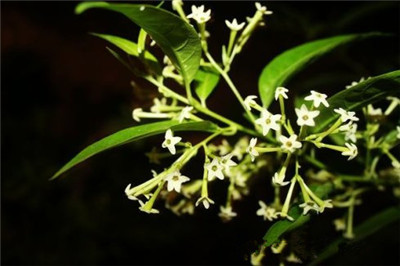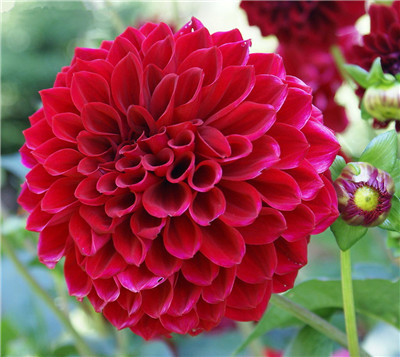Harvesting and storage of Dahlia root tuber
Dahlia is not cold-resistant, mainly because the root tuber can not be frozen, dahlia root tuber in 0. Dormancy begins at 5 degrees Celsius and frostbite occurs below 0 degrees Celsius. Therefore, it is impossible to overwinter in the open air in North China. Root tuber should be harvested before the arrival of early frost.
After frost, plants and leaves wither. At this point, the stems and leaves of the above-ground parts should be immediately cut off, root tuber dug out, potted plants can be removed from the pot or even pot into the greenhouse storage. Before harvest, varieties should be checked and selected to ensure the purity of varieties. Before storage, the withered stems and leaves should be cut off about 15 cm from the root neck. In order to prevent spraining of the root neck (the part that will sprout in the future), the root tuber should be dug out. After digging out the root tuber, dry it in the sun for 2-3 days before collecting it. To prevent frost at night, cover reed curtain or straw on root tuber. After the soil on the root tuber is dry, shake off the soil again, classify according to varieties, tie labels, and put it in a greenhouse with a temperature of not more than 5 degrees Celsius. At this time, maintaining a constant temperature of about 3~5 degrees Celsius and preventing excessive temperature are the keys to preserving the root tuber, because too high will make the foot bud of the root neck germinate ahead of time, consume water and nutrients, and affect the bulb, while too low will make the bulb rot by freezing.
In addition, the storage place should be sterilized. When swinging, the root neck is placed on the ground of the greenhouse. In order to prevent premature germination and heat rot, it is beneficial to stack 3~5 layers and bury them with slightly wet sand.

After frost, plants and leaves wither. At this point, the stems and leaves of the above-ground parts should be immediately cut off, root tuber dug out, potted plants can be removed from the pot or even pot into the greenhouse storage. Before harvest, varieties should be checked and selected to ensure the purity of varieties. Before storage, the withered stems and leaves should be cut off about 15cm from the root neck. In order to prevent sprain of the root neck (the part that will sprout in the future), the root tuber should be dug out. After digging out the root tuber, dry it in the sun for 2-3 days before collecting it. To prevent frost at night, cover reed curtain or straw on root tuber. After the soil on the root tuber is dry, shake off the soil again, classify it according to varieties, tie up labels, and put it in a greenhouse with a temperature of not more than 5℃. At this time, maintaining a constant temperature of about 3~5℃ and preventing excessive temperature are the keys to preserve the root tuber, because too high will make the foot bud of the root neck germinate ahead of time, consume water and nutrients, and affect the bulb, while too low will make the bulb rot by freezing. In addition, the storage place should be sterilized. When swinging, the root neck is placed on the ground of the greenhouse. In order to prevent premature germination and heat rot, 3~5 layers are generally stacked and buried with slightly wet sand. During winter storage, check frequently, cut off rotten and useless roots in time, if found buried sand is too dry, do not water directly, can take out the root tuber, then spray the sand wet, reach the moisture level, and then bury the root tuber again. In addition, the withered stems and leaves of potted plants can also be cut off, and the original pots are placed in a greenhouse with a temperature of no more than 3~5℃, and the pots are stacked and protected from direct light. During storage, if the pot soil is too dry, water a little (water should not be too large), keep the soil slightly moist, so as not to rot the roots. This method is simpler, but it takes up a larger storage area. Another storage method is to divide the dried root tuber together with the adventitious buds growing in the root neck. After segmentation, plant ash is coated on the cut, packed in a wooden trough or box, and dry sand or sawdust is filled in the pores. Then put the wooden trough or wooden box at 3~5℃, well ventilated, no direct light conditions for storage. Do not turn over during storage. This method is not only convenient for storage, but also convenient for access, and can save storage area. Dahlia some varieties of root tuber storage is more difficult, such as lotus chrysanthemum, fire tree honeysuckle and so on. When storing the roots of these varieties, do not mix them with other roots. Can be dried good root, placed in wooden boxes or flower pots, root can be covered with a small amount of dry sand, in 3~5℃ conditions for storage. In addition, the potted dahlia can also be moved into a greenhouse at 5 - 10 DEG C a few days before the arrival of frost period, flowers and buds are removed, and cultivated for about 15 - 20 days, so that nutrients are fully concentrated on the root tuber, and then the stems and leaves on the plant are removed, and the original pot or the pot is removed. How do dahlias survive winter? Dahlia root harvesting and storage Dahlia is known as one of the world's famous flowers, mainly because of its long flowering period, flower diameter, flowers and more. In northern China, the flowering period is from May to mid-November. Under suitable temperature conditions, it can bloom continuously every year, and the flowering is the most abundant after autumn. Dahlia is not cold-resistant, mainly because the root tuber can not be frozen, dahlia root tuber in 0. Dormancy begins at 5℃ and frostbite occurs below 0℃, so it is not allowed to overwinter in the open field in North China. Root tuber should be harvested before the arrival of early frost. After frost, plants and leaves wither. At this point, the stems and leaves of the above-ground parts should be immediately cut off, root tuber dug out, potted plants can be removed from the pot or even pot into the greenhouse storage. Before harvest, varieties should be checked and selected to ensure the purity of varieties. Before storage, the withered stems and leaves should be cut off about 15cm from the root neck. In order to prevent spraining of the root neck (the part that will sprout in the future), the root tuber should be dug out as a whole. After digging out the root tuber, dry it in the sun for 2-3 days before collecting it. To prevent frost at night, cover reed curtain or straw on root tuber. After the soil on the root tuber is dry, shake off the soil again, classify it according to varieties, tie up labels, and put it in a greenhouse with a temperature of not more than 5℃. At this time, maintaining a constant temperature of about 3~5℃ and preventing excessive temperature are the keys to preserve the root tuber, because too high will make the foot bud of the root neck germinate ahead of time, consume water and nutrients, and affect the bulb, while too low will make the bulb rot by freezing. In addition, the storage place should be sterilized. When swinging, the root neck is placed on the ground of the greenhouse. In order to prevent premature germination and heat rot, 3~5 layers are generally stacked and buried with slightly wet sand. During winter storage, check frequently, cut off rotten and useless roots in time, if found buried sand is too dry, do not water directly, can take out the root tuber, then spray the sand wet, reach the moisture level, and then bury the root tuber again. In addition, the withered stems and leaves of potted plants can also be cut off, and the original pots are placed in a greenhouse with a temperature of no more than 3~5℃, and the pots are stacked and protected from direct light. During storage, if the pot soil is too dry, water a little (water should not be too large), keep the soil slightly moist, so as not to rot the roots. This method is simpler, but it takes up a larger storage area. Another storage method is to divide the dried root tuber together with the adventitious buds growing in the root neck. After segmentation, plant ash is coated on the cut, packed in a wooden trough or box, and dry sand or sawdust is filled between the pores. Then put the wooden trough or wooden box at 3~5℃, well ventilated, no direct light conditions for storage. Do not turn over during storage. This method is not only convenient for storage, but also convenient for access, and can save storage area. Dahlia some varieties of root tuber storage is more difficult, such as lotus chrysanthemum, fire tree honeysuckle and so on. When storing the roots of these varieties, do not mix them with other roots. Can be dried good root, placed in wooden boxes or flower pots, root can be covered with a small amount of dry sand, in 3~5℃ conditions for storage. In addition, the potted dahlia can also be moved into a greenhouse at 5 - 10 DEG C a few days before the arrival of frost period, flowers and buds are removed, and cultivated for about 15 - 20 days, so that nutrients are fully concentrated on the root tuber, and then the stems and leaves on the plant are removed, and the original pot or the pot is removed.
- Prev

The planting method of evening primrose
Night incense is a flower which wins with night incense and has won people's love. Like a warm, humid, sunny environment, which can blossom all the year round. The country of origin is Mexico and South America. The planting method of evening primrose should pay attention to the following points. 1. Choose the insert. Branches with strong growth or free of diseases and insect pests should be selected.
- Next

Five taboos in the cultivation and maintenance of Dahlia (Dahlia)
Dahlia (Dahlia) is a perennial herbaceous flower with large and beautiful flower heads. If you want to plant a good dahlia, you should pay attention to the five taboos. -, avoid waterlogging Dahlia root is thick and succulent fleshy root, strong gas, requires loose air permeability, good drainage soil environment, if the soil is hardened, waterlogging hypoxia
Related
- Fuxing push coffee new agricultural production and marketing class: lack of small-scale processing plants
- Jujube rice field leisure farm deep ploughing Yilan for five years to create a space for organic food and play
- Nongyu Farm-A trial of organic papaya for brave women with advanced technology
- Four points for attention in the prevention and control of diseases and insect pests of edible fungi
- How to add nutrient solution to Edible Fungi
- Is there any good way to control edible fungus mites?
- Open Inoculation Technology of Edible Fungi
- Is there any clever way to use fertilizer for edible fungus in winter?
- What agents are used to kill the pathogens of edible fungi in the mushroom shed?
- Rapid drying of Edible Fungi

